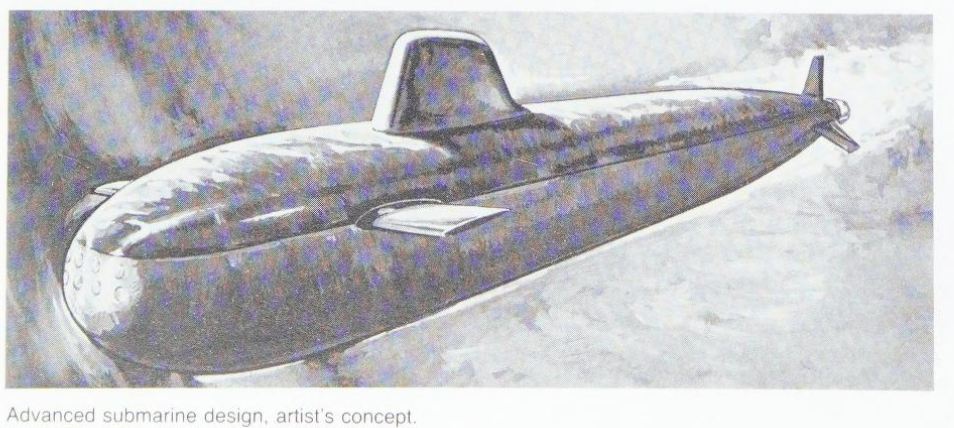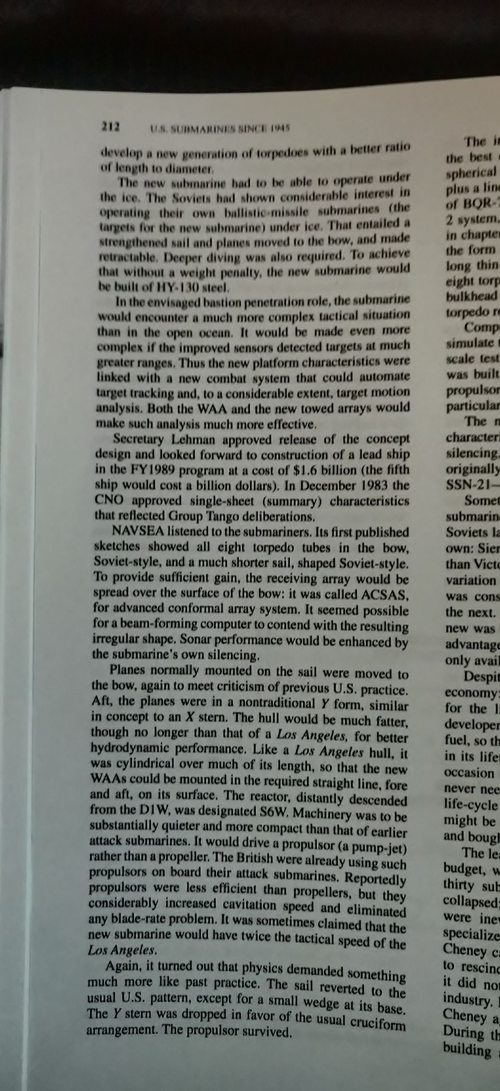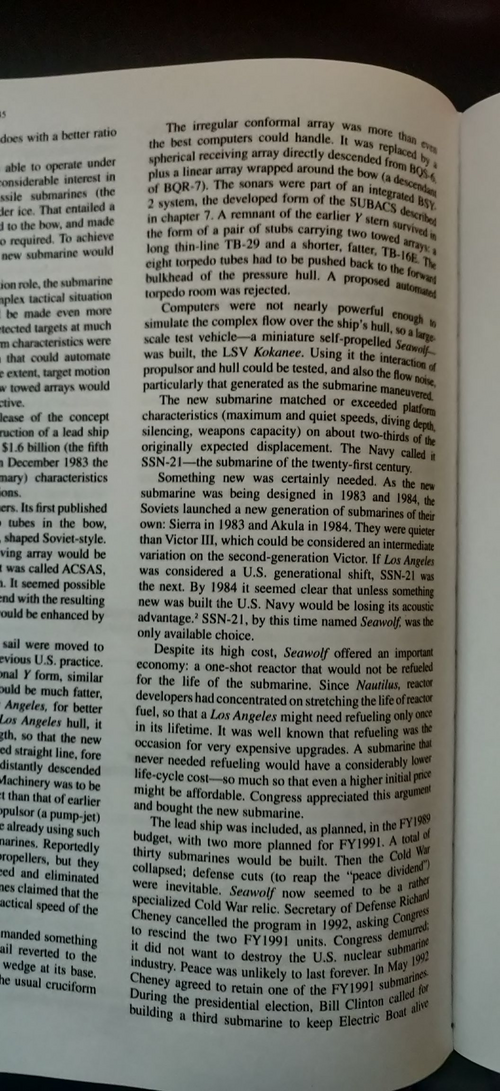Were there any concepts for the replacement of the Los Angeles-class attack submarine or other concepts for what became the Seawolf-class SSN-21?
You are using an out of date browser. It may not display this or other websites correctly.
You should upgrade or use an alternative browser.
You should upgrade or use an alternative browser.
Los Angeles-class Replacement Concepts/Seawolf-class
- Thread starter Triton
- Start date
- Joined
- 9 October 2009
- Messages
- 21,131
- Reaction score
- 12,221
Came across this yesterday in an old SBIR (Defense Small Business Innovation Research) document from March 1986:
SUBMITTED BY DEPT
----------------- -------
ABARIS NAVY
125 CATRON DR
RENO, NV 89512
CONTRACT NUMBER:
WILLIAM L MURPHY
TITLE:
ASSESSMENT OF FIBER REINFORCED PLASTICS FOR COMBATANT SUBMARINE
STRUCTURES
TOPIC# 50 OFFICE: NAVSEA
THE PRESSURE HULL OF A COMBATANT SUBMARINE WOULD BENEFIT FROM THE
CHARACTERISTICS OF COMPOSITES, AND THUS IS A GOOD CANDIDATE FOR THE
APPLICATION OF THESE MATERIALS. THE TWO CANDIDATE MATERIAL SYSTEMS
ARE THERMOSETS AND THERMOPLASTICS. THE PROJECT IS TO CONDUCT
PRELIMINARY DESIGN STUDIES OF THE PRIMARY HULL STRUCTURE, FRAMES,
JOINTS, PENETRATIONS, AND ATTACHMENTS USING GRAPHITE FIBERS AND
POLYETHERETHERKETON (PEEK) RESIN. DESIGNS WILL BE ANALYZED FOR
STRUCTURAL PERFORMANCE. A SCALE CANDIDATE HULL SECTION WILL BE
SELECTED, A DETAIL DESIGN CONDUCTED, AND TEST HULL SCALE SECTIONS
WILL BE BUILT. A TEST PLAN WILL BE DEVELOPED, AND A TEST FIXTURE
BUILT AND INSTRUMENTED. TESTS WILL BE CONDUCTED AND RESULTS
DOCUMENTED. PLAN FOR THE WORK OF A DEMONSTRATION AND VALIDATION
PHASE LEADING TO A MILESTONE II AND FULL SCALE ENGINEERING
DEVELOPMENT IS OFFERED AS AN OPTIONAL TASK.
carsinamerica
ACCESS: Confidential
- Joined
- 18 February 2010
- Messages
- 118
- Reaction score
- 57
The low-range alternative to the Seawolfs were originally called the Centurion. These later became the Virginia class, but they were considered at the time planning for the SSN-21 class was being reconsidered due to cost. The 15th edition of the Naval Institute Guide to the Ships and Aircraft of the US Fleet discusses it.
- Joined
- 16 April 2008
- Messages
- 9,011
- Reaction score
- 12,692
Centurion was of course after Seawolf.
Before Seawolf, there were several other proposed successors to the LA class.
First was the F/A (variously Fast Attack, Fleet Attack, and "Fat Albert). This was a small sub, roughly 5000 tons with a low length to beam ratio and performance more like a Sturgeon. This was a Zumwalt program intended to lower unit cost. Rickover savaged it and it never got far.
Rickover's preferred alternative was the Advanced High-Performance Nuclear Attack Submarine (AHPNAS), which was a giant, roughly twice the size of an LA, with a bank of vertical cruise missile launch tubes amidships, like an SSBN.
Before Seawolf, there were several other proposed successors to the LA class.
First was the F/A (variously Fast Attack, Fleet Attack, and "Fat Albert). This was a small sub, roughly 5000 tons with a low length to beam ratio and performance more like a Sturgeon. This was a Zumwalt program intended to lower unit cost. Rickover savaged it and it never got far.
Rickover's preferred alternative was the Advanced High-Performance Nuclear Attack Submarine (AHPNAS), which was a giant, roughly twice the size of an LA, with a bank of vertical cruise missile launch tubes amidships, like an SSBN.
- Joined
- 9 October 2009
- Messages
- 21,131
- Reaction score
- 12,221
This may well have been related:

Original Caption: A submarine is shown being tested in one of NASA's wind tunnels.
CREDIT: Paul Bagby
 www.space.com
www.space.com

Original Caption: A submarine is shown being tested in one of NASA's wind tunnels.
CREDIT: Paul Bagby
In this historical photo from the U.S. space agency, a navy submarine is shown undergoing tests in the National Transonic Facility on Oct. 3, 1986. Because air works in the same way as a liquid, it can be used to simulate the effects of water on a submarine hull.
Space History Photos | History of Space Exploration
The history of space exploration is rich with photos from NASA. Each weekday, SPACE.com looks back at the spaceflight through photos.
Attachments
Last edited by a moderator:
- Joined
- 9 October 2009
- Messages
- 21,131
- Reaction score
- 12,221
Evil Flower
ACCESS: Secret
- Joined
- 12 October 2006
- Messages
- 223
- Reaction score
- 59
Rickover of course also gutted the CONFORM program that produced a design that would have offered far greater performance at lower cost compared to the LA. As built the LA was inferior to the Sturgeon class that preceded it in almost all respects except for speed.TomS said:Centurion was of course after Seawolf.
Before Seawolf, there were several other proposed successors to the LA class.
First was the F/A (variously Fast Attack, Fleet Attack, and "Fat Albert). This was a small sub, roughly 5000 tons with a low length to beam ratio and performance more like a Sturgeon. This was a Zumwalt program intended to lower unit cost. Rickover savaged it and it never got far.
Rickover's preferred alternative was the Advanced High-Performance Nuclear Attack Submarine (AHPNAS), which was a giant, roughly twice the size of an LA, with a bank of vertical cruise missile launch tubes amidships, like an SSBN.
Aeroengineer1
Engineering, not just a job, but a lifestyle :)
- Joined
- 27 January 2008
- Messages
- 121
- Reaction score
- 99
The photo above of the sub in a wind tunnel is a photo of an LA class (flight 1-flight 4, not a 5 or 6) in the NASA Langley National Transonic Facility (hence the NTF in the picture). There is a circular pressure rake at the stern. From what I understand, this model was if not the largest, one of the largest models to go into that tunnel. It is a unique tunnel in that it is a cryogenic tunnel and can simulate velocities up to the Mach 1 region. It allows for simulation of high Re numbers better than most other tunnels.
To those that are wondering why I indicated that there are up to 6 flights of the LA class, not the typical 3, this is due to the fact that people, including some public military documents indicate that there are 3 flights or major hull configurations. My friend, who has served on the LA boats as well as later working maintenance has indicated to me that for maintenance purposes, there are 6 officially designated flights. Most of the differences are internal.
Adam
To those that are wondering why I indicated that there are up to 6 flights of the LA class, not the typical 3, this is due to the fact that people, including some public military documents indicate that there are 3 flights or major hull configurations. My friend, who has served on the LA boats as well as later working maintenance has indicated to me that for maintenance purposes, there are 6 officially designated flights. Most of the differences are internal.
Adam
moonbeamsts
ACCESS: Restricted
- Joined
- 5 March 2010
- Messages
- 44
- Reaction score
- 11
Greetings
I served on three 688's. The first being a third flight i.e. vls boat(ssgn) then first flight boat then a second flight boat.
My job was a sonarmen the description was accurate on sonar systems. The usn bit off to much it could chew when developing an/bsy-1. The tech was not avaiable, the software was a total fiaaco. Sonar development up until early 200's was ae evoloutionary affair. The current systems are a result of hardware and software finally catching up with each other and going with COTS which a vast improvement allowing easier upgrades to sonar and firecontrol.
JAM exsts/ss
exsts/ss
I served on three 688's. The first being a third flight i.e. vls boat(ssgn) then first flight boat then a second flight boat.
My job was a sonarmen the description was accurate on sonar systems. The usn bit off to much it could chew when developing an/bsy-1. The tech was not avaiable, the software was a total fiaaco. Sonar development up until early 200's was ae evoloutionary affair. The current systems are a result of hardware and software finally catching up with each other and going with COTS which a vast improvement allowing easier upgrades to sonar and firecontrol.
JAM
that_person
ACCESS: Secret
- Joined
- 25 May 2021
- Messages
- 301
- Reaction score
- 558
Early Seawolf concept, dated ~1984. According to Friedman, the Seawolf we got was a much more toned down version of what the USN actually wanted. They originally wanted a Soviet-style sail, a Y-plane arrangement for the rudders and dive planes, and to some degree, bow-mounted torpedo tubes (meaning a conformal rather than spherical array), and automated torpedo reloading systems. This was all dropped due to cost, and the computers at the time weren't able to simulate the maths to make the design work. It's also interesting to note that it was supposed to have HY-130 steel, and quietness over speed was prioritized. I have attached a small excerpt from Friedman's Revised Submarines below. The image source comes from Polmar's Ships and Aircraft of the US Fleet: 13th Edition






Last edited:
- Joined
- 4 July 2010
- Messages
- 2,397
- Reaction score
- 2,706
There's some more detail to be found out there if one is interested. The Y-tail turned out to suffer substantial disadvantages compared to the traditional or X-tails. The "soviet style" sail was tested extensively and was in serious consideration a few times over the decades, but never made it for various reasons (under-ice performance is the one mentioned the most). You can do bow torpedoes without an advanced conformal array, several navies use them paired with a cylindrical array underneath in a "chin" mount, but the angled tubes are fine if the bow is otherwise occupied. The angled tubes eventually gave us the ability to do the VPT, I will note. HY-130 welding is a huge, huge problem that the Navy has never economically solved. I expect they are looking at it again for the next SSN.Early Seawolf concept, dated ~1984. According to Friedman, the Seawolf we got was a much more toned down version of what the USN actually wanted. They originally wanted a Soviet-style sail, a Y-plane arrangement for the rudders and dive planes, and to some degree, bow-mounted torpedo tubes (meaning a conformal rather than spherical array), and automated torpedo reloading systems. This was all dropped due to cost, and the computers at the time weren't able to simulate the maths to make the design work. It's also interesting to note that it was supposed to have HY-130 steel, and quietness over speed was prioritized. I have attached a small excerpt from Friedman's Revised Submarines below. The image source comes from Polmar's Ships and Aircraft of the US Fleet: 13th Edition
View attachment 685081
View attachment 685083
View attachment 685084
As "watered down" as it may have been, the SSN-21 design was still a leap forward.
phantomphan
ACCESS: Confidential
- Joined
- 27 July 2020
- Messages
- 66
- Reaction score
- 133
Why is this?As built the LA was inferior to the Sturgeon class that preceded it in almost all respects except for speed.
that_person
ACCESS: Secret
- Joined
- 25 May 2021
- Messages
- 301
- Reaction score
- 558
Sturgeons had under-ice capability that the early 688s did not, they had deeper test depths, and presumably where cheaper and required less manning.Why is this?As built the LA was inferior to the Sturgeon class that preceded it in almost all respects except for speed.
Last edited:
Kat Tsun
eeeeeeeeeeeeeee
- Joined
- 16 June 2013
- Messages
- 1,200
- Reaction score
- 1,527
Why is this?As built the LA was inferior to the Sturgeon class that preceded it in almost all respects except for speed.
Early LA class subs had thinner hulls for weight reduction purposes. This is why they were faster, Rickover preferred a fast attack over a deep diving attack submarine. Hull strength specs were equivalent to Sturgeon prior to this. Virginias are similar ~1,000 foot crush depth but have HY100 hulls I think, so they're even faster than 688s.
The former is mentioned in a Friedman book anyway.
774s can probably just be considered a PI 688i tbh tho.
Sturgeons had under-ice capability, presumably where cheaper and required less manning.Why is this?As built the LA was inferior to the Sturgeon class that preceded it in almost all respects except for speed.
So do all 688is as well. The worse characteristics of 688 were predominantly due to its design emphasis on high speed which necessitated a weaker/lighter hull. Whether this is good or bad is still an open question.
Last edited:
Similar threads
-
-
Warship Classification/Designation Discussion
- Started by Yellow Palace
- Replies: 57
-
SSN (X) - Seawolf Redux or something far larger?
- Started by Ironmiked
- Replies: 240
-
-
NSSN Virginia-class - current status and future
- Started by Triton
- Replies: 335

